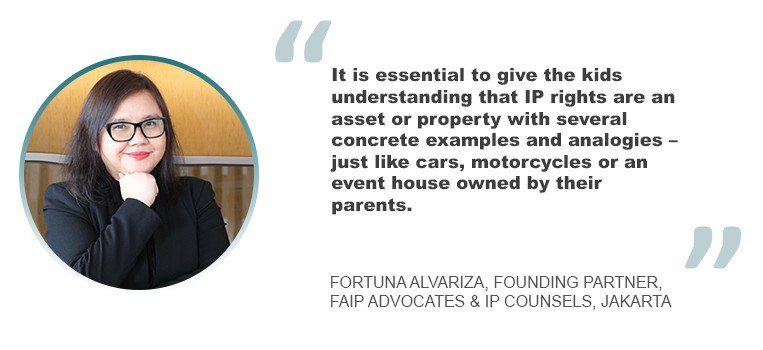Why your kids need to know their IP rights
31 May 2024

Teaching children about IP rights prepares them for the evolving digital economy, but it comes with challenges for it to be effective learning. Excel V. Dyquiangco discusses where to start, such as basic concepts and age-appropriate curriculum.

Children nowadays are both content providers and consumers, constantly creating new ideas of expression through music or storytelling, photography or art. However, are they aware of how critical it is to safeguard their intellectual property rights?
“Teaching kids about IP rights can raise awareness of creativity and innovation and foster respect towards others’ IP rights,” said Sonal Madan, a partner at Chadha & Chadha in Gurugram. It also discourages inadvertent plagiarism and promotes a mindset of asking permission before acting and giving credit where it is due.
When it comes to copyright, for example, communicating this concept can come in when children write or create stories or artwork of their own. “This means they have the authority to decide who can use their work and how,” she said. “This can help kids understand that they must ask for permission before using someone else’s work. In terms of trademarks, kids can be taught that they represent ownership and serve to identify the source of a particular product. For instance, children can be taught how the name of their favorite chocolate brand helps in identifying and differentiating it from other chocolates available for purchase.”

Benjamin Cheong, deputy head of technology, media and telecommunications at Rajah & Tann in Singapore, echoed this view. He said that with the rise of the digital economy, intangible assets and IP will be the drivers of the future economy. “Just as it was important to teach kids life skills such as mathematics and spelling to prepare them for a vocation in later life, many of the kids now learn simple coding, creative writing and drawing at a young age to prepare them for the digital economy,” he said. “We should teach kids IP rights from a young age to prepare them for later life.”
He added that among the key IP rights essential for children to understand should include teaching them that works such as stories, drawings and videos are protected and cannot be copied for others’ use without permission. These concepts can be taught in school or during creative activities through talking, watching videos and using real-life examples.

For Fortuna Alvariza, founding partner at FAIP Advocates & IP Counsels in Jakarta, teaching children their basic IP rights can start with analogies. “It is essential to give the kids understanding that IP rights are an asset or property with several concrete examples and analogies – [just like] cars, motorcycles or an event house owned by their parents,” she said.
She explained: “We all understand that no one can use their parents’ car unless their parents give permission or consent to use it. If their neighbour suddenly uses their parents’ car without permission, the neighbour can be considered as stealing the car. If they can understand that they cannot steal something owned by other people or use other people’s stuff without any consent of the owner, I believe they can also understand the similar concept for IP rights.”
Overcoming challenges
While educating children about the intricacies of IP rights might not be suitable at a young age, introducing the fundamental concepts in a simplified manner is crucial. Madan said: “The concepts can seem complicated, which is why it’s important to introduce the basics in a simplified format, such as the idea of ownership and authorship. When teaching IP rights to kids, consider their age and create the right balance. Instead of stifling creativity by teaching them about strict rights, strike a fair balance and teach them that these concepts are helpful to them. This can help maintain a fluid environment of innovation and learning.”
Alvariza added that another one of the challenges she sees is how to explain the nature of the IP as an object, since it is an intangible asset.
“Further, it would also be useful if we can give them a brief and very basic introduction on the concept of licensing – if their favorite lunch box would like to use a famous cartoon character of a movie owned by a movie company, the lunch box company has to get the permission first from the movie company, and usually must pay the license which is more or less like paying the rent,” she said.
However, many people still believe that IP rights are not a priority compared to more pressing issues, such as poverty and poor nutrition. Alvariza doesn’t disagree, but she believes both issues can be addressed simultaneously, especially since many regions in Indonesia no longer have poverty and poor nutrition as a problem.
“I believe that teaching IPR to young students would be useful to plant the basic idea in their head that IPR must be respected and encourage them to implement that idea in their daily life,” she said. “We can see the impact of good socialization that has little by little changed the mindset of Indonesians, who at least now understand that using fake products is wrong, compared to 20 years ago when many people still thought that using fake products is okay.”
Collaboration with the system
To enhance IP education among young learners, seeking help from external sources is also helpful. Madan highlighted the importance of a collaboration between educators and IP lawyers to develop strategies for teaching the concept of IP rights in age-appropriate ways, considering the required level of comprehension.
“With the combined expertise, a simple curriculum that aligns with educational standards can be created to facilitate learning,” she said. “However, there is a lack of up-to-date teaching materials on emerging issues surrounding IP rights. In my opinion, regular updates to the IP curriculum, in consultation with IP specialists, can help mitigate the issue of redundancy in the IP course structure.”
Furthermore, Madan suggested inviting IP experts as guest speakers to introduce students to the world of IP rights. “IP lawyers can also provide professional insights and knowledge to educators through lectures, which can then be further introduced to students through appropriate means. Additionally, IP lawyers could collaborate to write simplified books for high school students to learn about intellectual property,” she said.
Cheong agreed, saying: “IP lawyers and educators should communicate to understand the comprehension level of children at each level and work together to ensure that the concepts that are being taught are simplified to the appropriate level and yet attractive enough for the kids to want to learn. Public awareness is important. Lawyers can participate in talks in schools or organized by public bodies, such as the local IP offices, police, libraries and TV programs where IP is discussed. IP lawyers can also work with the local IP offices or schools to prepare education materials relating to IP.”






